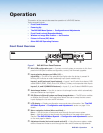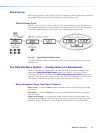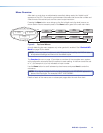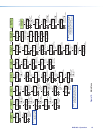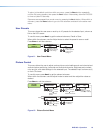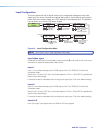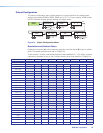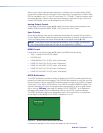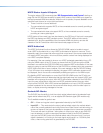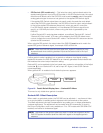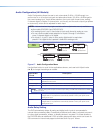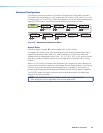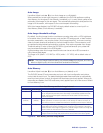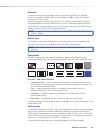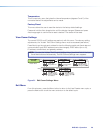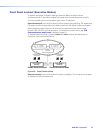
HDCP Status: Inputs & Outputs
Through a series of SIS commands (see “SIS Communication and Control” starting on
page 34) the DVS 605 has the ability to report HDCP status of the HDMI input signals as
well as connected HDMI sink devices. When the unit is queried, it reports feedback on the
specified input (source) or output (sink) as follows:
• There is no sink or source attached.
• The connected sink supports HDCP, or the connected source is currently providing a
HDCP encrypted signal.
• The connected sink does not support HDCP, or the connected source is currently
providing an unencrypted signal.
HDCP status of the current input can be viewed on the OSD bug. If the input is encrypted
the OSD bug displays an HDCP padlock symbol. The HDCP status of the currently
selected input, and the capabilities of the connected HDMI sink device, can also be
viewed on the AV Controls bar within the internal web pages of the unit.
HDCP Authorized
The HDCP Authorized function allows the DVS 605 HDMI inputs to be able to report
as an HDCP authorized sink or a non‑HDCP authorized sink device to a source. This is
especially useful for sources that will encrypt their output even if the source material does
not require HDCP encryption, which would then prevent content from being displayed on
non‑HDCP compliant displays.
For example, if the user wanted to show a non‑HDCP protected presentation from a PC
using the HDMI output of the PC, there is a chance that the PC will encrypt the HDMI,
because it can see that the DVS 605 HDMI input supports HDCP authorization. If the user
were only going to use the HDMI output of the DVS 605 to a display (sink) that supported
HDCP, there would be no issue; however, if the user wanted to use the DVS 605 analog
15‑pin HD output to an analog sink (display), the green HDCP notification screen would
be displayed, due to the source unnecessarily enabling encryption on its HDMI output.
By disabling HDCP authorization on one of the DVS 605 HDMI inputs, the PC with non‑
HDCP protected content will determine that the signal path does not support HDCP, and
therefore will not encrypt its output. With HDCP authorization disabled on the DVS 605’s
input, the user will be able to view their non‑HDCP protected content from any video
output of the DVS 605. With HDCP authorized disabled on an input, if HDCP protected
content is selected on the source, the source will either simply mute its video output to
black, or display a warning message to the user.
Genlock/AFL Modes
The DVS 605 has the ability to lock the output vertical refresh rate to the selected input
signal vertical refresh rate (AFL), or to an applied SDI Genlock signal (SDI models only).
The 3 available modes for genlock are:
• Off — A free running pixel clock is generated internally by the DVS 605.
• Input AFL — This mode locks the output vertical refresh rate to the vertical refresh
rate of the currently selected input using Extron Accu‑Rate Frame Lock technology to
ensure no frames of the input are repeated or dropped due to frame rate conversion.
This mode will result in glitches / interruptions in output sync when a new DVS 605
input is selected, or when a new signal has been routed to the DVS 605 selected
input, as the DVS 605 locks to the vertical refresh rate of the new input. If no input
signal is detected, or if locking to the input signal would result in a >165 MHz pixel
clock, a free running pixel clock is generated by the DVS 605.
DVS 605 • Operation 20



